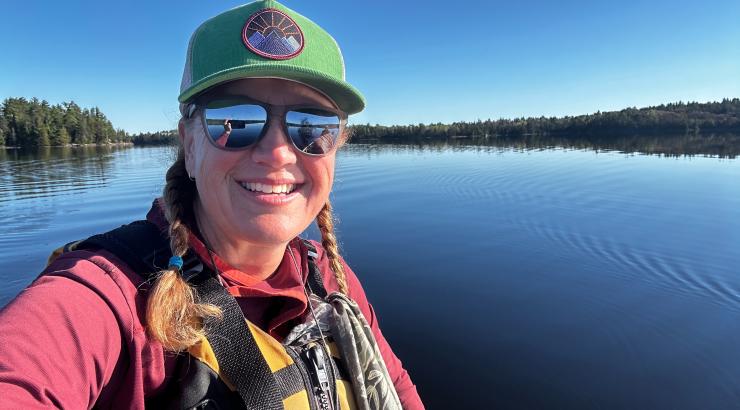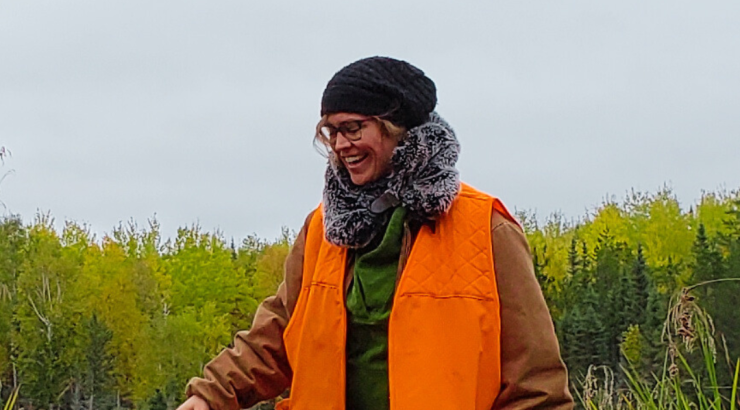Four hours north of Minneapolis in the small town of Ely, lies the basecamp of Boundary Waters Canoe Area Wilderness (BWCA) and the headquarters of Campaign to Save the Boundary Waters. Nestled on the main drag is the home of Ely Outfitting Company (by far one of the most beautiful outfitters I’ve ever seen). Jason Zaborkrtsky, the amazing owner, and Mikah Meyer of Outdoor Safe space planned this trip two years ago, then the pandemic brought it to a screeching halt. Fortunately, they didn’t let that kill the trip completely. Fast forward two years with a little patience and a lot of perseverance the trip was back on with nine queers in tow who were ready to paddle!
First, let me introduce you to the Boundary Waters Wilderness. Consisting of 4.3 million acres, the Quetico-Superior Ecosystem is a plethora of parks including Voyageurs National Park, Quetico Provincial Park, and the Superior National Forest. Combined they make up the boundless landscape known as the Boundary Waters Wilderness. These expansive areas are native lands to the Anishinaabe people (Chippewa or Ojibwe) and is truly like no other. Eleven tribes call this land home, and they continue to harvest wild rice and fish as well as hunt what land lies between the water. There are over 1,100 lakes connected by rivers and portages and remains one of the few places in the United States where you can drink straight from the lakes.
The Boundary Waters is supposed to be protected as a Wilderness, but encroachment along the edges and within the watershed that flows into the through the heart of the Wilderness threatens to destroy the landscape and existing ecosystem with copper mining done by the Twin Metals Company, which can poison the water and destroy local habitats for wildlife. We set out on this trip with that in mind.
This trip, like so many paddling trips I’ve been on, started out wet. Rain may sound like an awful way to start a multiday back country trip, but for me I weirdly enjoy it as it helps me test my resilience and reminds me to be grateful (plus there is nothing like the smell of a damp boreal forest). There was so much to be grateful for too. The ever-changing flow of the narrow waterways, the fields of wild rice that beckons to be reached out to and eaten (which I did), and the red and white pines that towered over us on the portages were constant reminders of how truly special the area is.
Our journey began at entry point 16 with a very rainy 176 rod portage to Moose River. A rod is 16.5 feet or 5 meters. A portage -if you aren’t familiar -is when you yell “Uff da” grab a canoe, sling it on your shoulders, and trek into the forest to the next entry point. After many “Uff das” were expressed, we continued north to Nina Moose Lake finding two more portages, each measuring 26 rods, as well as crossing over a handful of beaver dams. Nina Moose Lake welcomed us to a lighter rain, and although we were soggy, our enthusiasm would not falter. With a surface area of 411 acres there was no lily dipping allowed on this crossing. We continued north to Nina Moose River and paddled 11-miles to our camp for the next three nights. Lake Agnes’ rocky shore awaited us with plenty of space to set up camp and the best view was set aside for the latrine, a luxury in this remote area.
On day two we headed five miles north again to Lac La Croix, the international waterway of Canada and the United States, and one of the only lakes in the boundary waters that allows motorized boats. This lake will make your jaw drop, boasting 29,596 acres, with a maximum depth of 168 feet surrounded by 482.4 miles of shoreline, this lake is a shinning jewel in the vast Boundary Waters Wilderness. The beautiful shoreline, perfect for swimming and fishing, is also where you can find mesmerizing pictographs located on the Canadian cliffsides I suppose it’s hard to imagine its beauty until you’ve dipped your paddle in these waters.
After a day of sun, exploring the Canadian border, and fishing we made our way south back to camp. Although we had caught a couple of small mouth bass that day, nature had other plans and a snapping turtle ended up with a full stomach and an easy meal. Not to worry folks, the next day we caught a 24-inch walleye and two small mouth bass which made a nice feast. The night was filled with unforgettable conversation, personal pizzas cooked on the fire, and was topped off with a late-night show from a family of otters. This could not have been a better way to spend our last night on Lake Agnes.
Our last morning, we woke up to sunny skies and glass-like water. But this was the day we weren’t looking forward to. Every paddle stroke was a reminder that this trip was slowly coming to its end. The 11-mile trek gave us time to reflect. In the backcountry, time seems to slow down, social media disappears, and current events are irrelevant.
I’m sure you’re wondering, what do a bunch of queers have to do with raising awareness for the Boundary waters? The fact is environmental issues and social justice issues go together. You can’t have one without the other. A lot of this trip consisted of conversations about how rural areas don’t welcome diversity. How BIPOC and the LGBQT+ community don’t feel welcome or safe in rural or remote places. Some feel as though they need to mask themselves when going to these areas. Which in this case is when someone that identifies as LGBQT+ feels as though they need to change their whole persona to appear “less queer” whether that be on the trail, paddling or at the trailhead.

Have you ever felt this way? If you said yes, please know you have support. There are multiple groups in Oregon and around the country that support BIPOC and LGBTQ+ people in the outdoors. For those of you who have never felt this way, I encourage you to ask yourself what you can do to help create safe spaces. Building community takes work, but sometimes a simple “hi” in these outside spaces can contribute to building a foundation to create safe spaces. Outside Safe Space has a concept for this. A simple rainbow tree pin or sticker to put on your pack, hat, water bottle, or any piece of gear can help others feel safe in these outside spaces. You might think it’s just a sticker, how can that make a difference? I think we all know that when we realize we have one thing in common with someone it can lead to a million other conversations and connections. After all we are going into these places to seek connection to ourselves, to the land and to others.
On this trip I learned that self-exploration is never ending. We are always pursuing answers, connections, and self-worth, that a lot of people seek when exploring outdoor spaces. I also learned to judge myself less and give myself permission to heal and to take my power back which was something that I wasn’t alone in learning. Even within the communities (i.e., LGBTQ+) there’s a division we need to recognize that privilege still lives here. Those who have that privilege need to acknowledge it and use it to create change on and off the trail. Healing takes time and building community takes time just don’t forget to give yourself grace. These spaces are for everyone and it’s up to us to create those safe spaces so that everyone has the opportunity to heal, connect, and of course have FUN!


